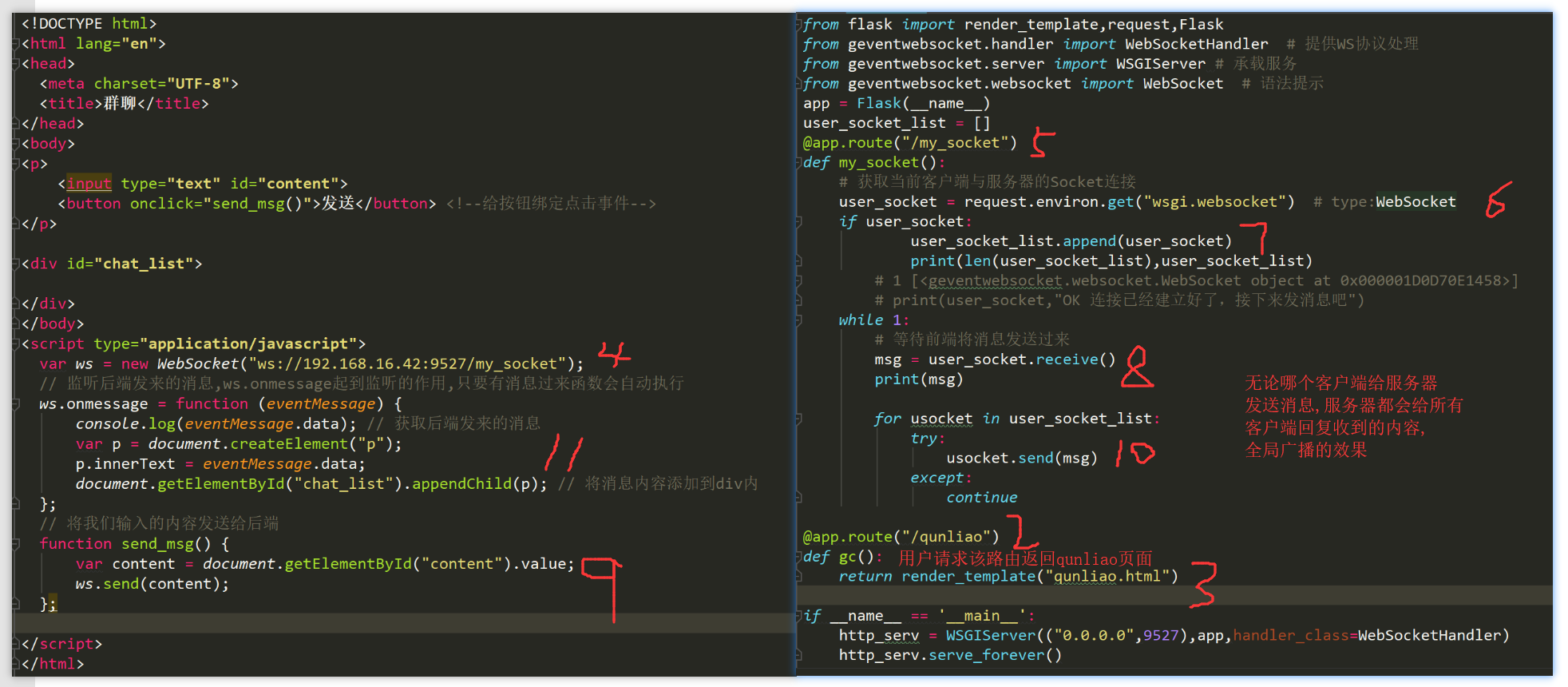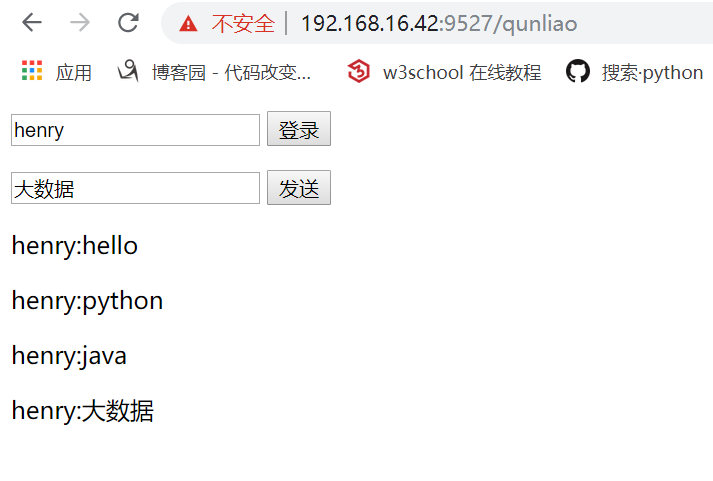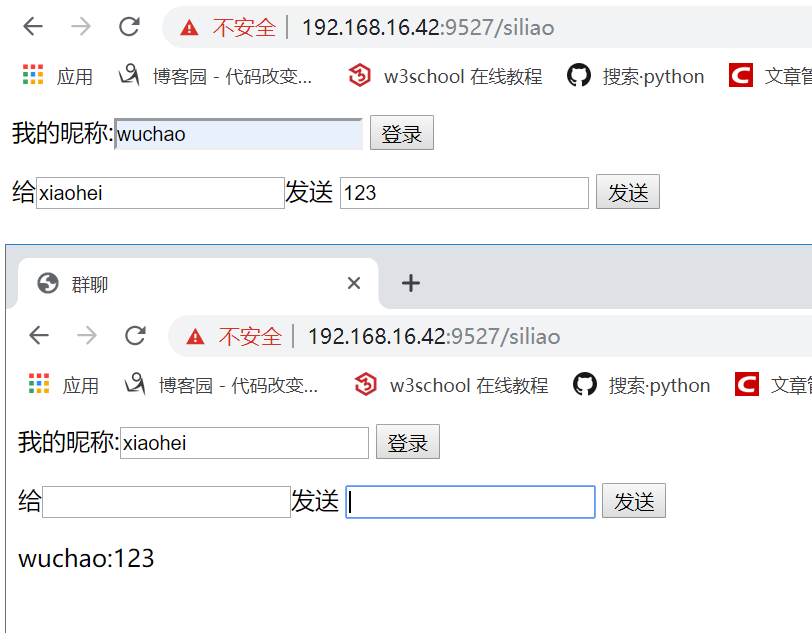Flask-websocket实现聊天功能
群聊无昵称
原生js代码
<!DOCTYPE html>
<html lang="en">
<head>
<meta charset="UTF-8">
<title>群聊</title>
</head>
<body>
<p>
<input type="text" id="content">
<button onclick="send_msg()">发送</button> <!--给按钮绑定点击事件-->
</p> <div id="chat_list"> </div>
</body>
<script type="application/javascript">
var ws = new WebSocket("ws://192.168.16.42:9527/my_socket");
// 监听后端发来的消息,ws.onmessage起到监听的作用,只要有消息过来函数会自动执行
ws.onmessage = function (eventMessage) {
console.log(eventMessage.data); // 获取后端发来的消息
var p = document.createElement("p");
p.innerText = eventMessage.data;
document.getElementById("chat_list").appendChild(p); // 将消息内容添加到div内
};
// 将我们输入的内容发送给后端
function send_msg() {
var content = document.getElementById("content").value;
ws.send(content);
}; </script>
</html>
后端逻辑代码
# -*- coding: utf-8 -*-
# @Time : 2019/7/15 16:42 from flask import render_template,request,Flask
from geventwebsocket.handler import WebSocketHandler # 提供WS协议处理
from geventwebsocket.server import WSGIServer # 承载服务
from geventwebsocket.websocket import WebSocket # 语法提示 app = Flask(__name__) user_socket_list = []
@app.route("/my_socket")
def my_socket():
# 获取当前客户端与服务器的Socket连接
user_socket = request.environ.get("wsgi.websocket") # type:WebSocket
if user_socket:
user_socket_list.append(user_socket)
print(len(user_socket_list),user_socket_list)
# 1 [<geventwebsocket.websocket.WebSocket object at 0x000001D0D70E1458>]
# print(user_socket,"OK 连接已经建立好了,接下来发消息吧")
while 1:
# 等待前端将消息发送过来
msg = user_socket.receive()
print(msg) for usocket in user_socket_list:
try:
usocket.send(msg)
except:
continue @app.route("/qunliao")
def gc():
return render_template("qunliao.html") if __name__ == '__main__':
http_serv = WSGIServer(("0.0.0.0",9527),app,handler_class=WebSocketHandler) # 这种启动方式和app.run()不冲突,该启动方式发什么请求都可以接受到
http_serv.serve_forever()
流程
1、用户在网页请求http://192.168.16.42:9527/qunliao
2、请求/qunliao这个路由走后端对应的视图函数gc返回qunliao.html这个页面,
3、页面在加载的过程中走到script代码时建立WebSocket连接请求ws://192.168.16.42:9527/my_socket,
4、ws://192.168.16.42:9527/my_socket请求走后端对应的视图函数,获取当前客户端与服务器的socket连接对象,调用该对象的receive方法,等待前端发来消息,
5、前端我们通过给input框绑定点击事件,获取用户输入的内容发送给服务器;
6、后端将前端发来的消息在发送给前端;
7、前端通过ws.onmessage这个事件监听着后端过来的消息,只要有消息就会自动触发函数执行并获取数据;
第一步是浏览器向/quliao这个路径发起请求:

jQuery
<!DOCTYPE html>
<html lang="en">
<head>
<meta charset="UTF-8">
<title>群聊</title>
</head>
<body>
<p>
<input type="text" id="content">
<button id="send_msg" >发送</button> <!--给按钮绑定点击事件-->
</p> <div id="chat_list"> </div>
</body>
<script src="/static/jquery-3.4.1.js"></script>
<script type="application/javascript">
var ws = new WebSocket("ws://192.168.16.42:9527/my_socket");
// 监听后端发来的消息,ws.onmessage起到监听的作用,只要有消息过来函数会自动执行
ws.onmessage = function (eventMessage) {
console.log(eventMessage.data); // 获取后端发来的消息
var p = document.createElement("p"); // 创建一个p标签
p.innerText = eventMessage.data; // 将后端发来的数据添加到p标签内
$("#chat_list").append(p) // 将p标签添加到div内
};
// 将我们输入的内容发送给后端
$("#send_msg").click(function () {
var content = $("#content").val();
ws.send(content);
})
</script>
</html>
前端代码
from flask import render_template,request,Flask
from geventwebsocket.handler import WebSocketHandler # 提供WS协议处理
from geventwebsocket.server import WSGIServer # 承载服务
from geventwebsocket.websocket import WebSocket # 语法提示
app = Flask(__name__,static_folder="statics",static_url_path="/static") # 获取静态文件
user_socket_list = []
@app.route("/my_socket")
def my_socket():
# 获取当前客户端与服务器的Socket连接
user_socket = request.environ.get("wsgi.websocket") # type:WebSocket
if user_socket:
user_socket_list.append(user_socket)
print(len(user_socket_list),user_socket_list)
# 1 [<geventwebsocket.websocket.WebSocket object at 0x000001D0D70E1458>]
# print(user_socket,"OK 连接已经建立好了,接下来发消息吧")
while 1:
# 等待前端将消息发送过来
msg = user_socket.receive()
print(msg)
for usocket in user_socket_list:
try:
usocket.send(msg)
except:
continue @app.route("/qunliao")
def gc():
return render_template("qunliao.html") if __name__ == '__main__':
http_serv = WSGIServer(("0.0.0.0",9527),app,handler_class=WebSocketHandler)
http_serv.serve_forever()
后端代码
带群昵称的群聊
通过动态路由参数获取前端传过来的用户名
<!DOCTYPE html>
<html lang="en">
<head>
<meta charset="UTF-8">
<title>群聊</title>
</head>
<body>
<input type="text" id="username">
<button id="login">登录</button>
<p>
<input type="text" id="content">
<button id="send_msg" >发送</button> <!--给按钮绑定点击事件-->
</p> <div id="chat_list"> </div>
</body>
<script src="/static/jquery-3.4.1.js"></script>
<script type="application/javascript">
var ws = null; // 创建全局变量,ws多处使用 $("#login").click(function () {
var username = $("#username").val();
console.log(username);
// 创建一个websocket对象,建立websocket连接,更改了全局的ws,将用户名拼接上
ws = new WebSocket("ws://192.168.16.42:9527/my_socket/" + username); // 监听后端发来的消息,ws.onmessage起到监听的作用,只要有消息过来函数会自动执行
ws.onmessage = function (eventMessage) {
console.log(eventMessage.data); // 获取后端发来的消息
var str_obj = JSON.parse(eventMessage.data); // 反序列化,因为我们在发送给后端的时候是json
var p = document.createElement("p"); // 创建一个p标签
$(p).text(str_obj.from_user +":"+str_obj.chat); // 将dom对象转换成jQuery对象,将后端发来的数据添加到p标签内
$("#chat_list").append(p) // 将p标签添加到div内
};
}); // 将我们输入的内容发送给后端
$("#send_msg").click(function () {
var content = $("#content").val();
var username = $("#username").val();
// 将要发送的内容封装成自定义对象
var sendStr = {
from_user:username,
chat:content
};
console.log(sendStr);
// 序列化后发送给后端
ws.send(JSON.stringify(sendStr));
});
</script>
</html>
前端代码
from flask import render_template,request,Flask
from geventwebsocket.handler import WebSocketHandler # 提供WS协议处理
from geventwebsocket.server import WSGIServer # 承载服务
from geventwebsocket.websocket import WebSocket # 语法提示
app = Flask(__name__,static_folder="statics",static_url_path="/static")
user_socket_dict = {} # 建立websocket连接时,前端将名字发送过来了
@app.route("/my_socket/<username>")
def my_socket(username):
# 获取当前客户端与服务器的Socket连接
user_socket = request.environ.get("wsgi.websocket") # type:WebSocket if user_socket:
# 以名字为key,连接对象为value添加到字典中
user_socket_dict[username] = user_socket
while 1:
# 等待前端将消息发送过来,此时是json数据
msg = user_socket.receive()
for usocket in user_socket_dict.values():
try:
# 将收到的信息在发送给所有与服务器建立连接的前端
usocket.send(msg)
except:
continue @app.route("/qunliao")
def gc():
return render_template("qunliaonicheng.html") if __name__ == '__main__':
http_serv = WSGIServer(("0.0.0.0",9527),app,handler_class=WebSocketHandler)
http_serv.serve_forever()
后端代码
效果:

websocket实现私聊
<!DOCTYPE html>
<html lang="en">
<head>
<meta charset="UTF-8">
<title>群聊</title>
</head>
<body>
我的昵称:<input type="text" id="username">
<button id="login">登录</button>
<p>
给<input type="text" id="to_user">发送
<input type="text" id="content">
<button id="send_msg" >发送</button> <!--给按钮绑定点击事件-->
</p> <div id="chat_list"> </div>
</body>
<script src="/static/jquery-3.4.1.js"></script>
<script type="application/javascript">
var ws = null; // 创建全局变量,ws多处使用 $("#login").click(function () {
var username = $("#username").val();
console.log(username);
// 创建一个websocket对象,建立websocket连接,更改了全局的ws,将用户名拼接上
ws = new WebSocket("ws://192.168.16.42:9527/my_socket/" + username); // 监听后端发来的消息,ws.onmessage起到监听的作用,只要有消息过来函数会自动执行
ws.onmessage = function (eventMessage) {
console.log(eventMessage.data); // 获取后端发来的消息
var str_obj = JSON.parse(eventMessage.data); // 反序列化,因为我们在发送给后端的时候是json
var p = document.createElement("p"); // 创建一个p标签
$(p).text(str_obj.from_user +":"+str_obj.chat); // 将dom对象转换成jQuery对象,将后端发来的数据添加到p标签内
$("#chat_list").append(p) // 将p标签添加到div内
};
}); // 将我们输入的内容发送给后端
$("#send_msg").click(function () {
var content = $("#content").val();
var username = $("#username").val();
var to_user = $("#to_user").val();
// 将要发送的内容封装成自定义对象
var sendStr = {
from_user:username,
chat:content,
to_user:to_user,
};
console.log(sendStr);
// 序列化后发送给后端
ws.send(JSON.stringify(sendStr));
});
</script>
</html>
前端页面
import json
from flask import render_template,request,Flask
from geventwebsocket.handler import WebSocketHandler # 提供WS协议处理
from geventwebsocket.server import WSGIServer # 承载服务
from geventwebsocket.websocket import WebSocket # 语法提示
app = Flask(__name__,static_folder="statics",static_url_path="/static")
user_socket_dict = {} # 建立websocket连接时,前端将名字发送过来了
@app.route("/my_socket/<username>")
def my_socket(username):
# 获取当前客户端与服务器的Socket连接
user_socket = request.environ.get("wsgi.websocket") # type:WebSocket if user_socket:
# 以名字为key,连接对象为value添加到字典中
user_socket_dict[username] = user_socket
while 1:
# 等待前端将消息发送过来,此时是json数据
msg = user_socket.receive()
print(msg) # {"from_user":"wuchao","chat":"123","to_user":"xiaohei"}
# 反序列化
msg_dict = json.loads(msg)
# 查找字典中前端要发送信息给那个人的名字
to_username = msg_dict.get("to_user")
# 获取目标人物的连接地址
to_user_socket = user_socket_dict.get(to_username)
# 将信息发送给目标人物
to_user_socket.send(msg) @app.route("/siliao")
def gc():
return render_template("siliao.html") if __name__ == '__main__':
http_serv = WSGIServer(("0.0.0.0",9527),app,handler_class=WebSocketHandler)
http_serv.serve_forever()
后端代码
效果

Flask-websocket实现聊天功能的更多相关文章
- spring boot集成websocket实现聊天功能和监控功能
本文参考了这位兄台的文章: https://blog.csdn.net/ffj0721/article/details/82630134 项目源码url: https://github.com/zhz ...
- 基于vs2015 SignalR开发的微信小程序使用websocket实现聊天功能
一)前言 在微信小程上实现聊天功能,大致有三种方式:1)小程序云开发 2)购买第三方IM服务 3)使用自己的服务器自己开发. 这里重要讲使用自己的服务器自己开发,并且是基于vs的开发. 网上提供的解决 ...
- 在Spring Boot框架下使用WebSocket实现聊天功能
上一篇博客我们介绍了在Spring Boot框架下使用WebSocket实现消息推送,消息推送是一对多,服务器发消息发送给所有的浏览器,这次我们来看看如何使用WebSocket实现消息的一对一发送,模 ...
- websocket 实现聊天功能
<html> <head> <base href="<%=basePath%>"> <title>webscoket t ...
- 基于java 的websocket的聊天功能,一开始初始化websocket,执行打开连接之后就直接关闭连接了。
1 错误描述: java 后台没有报错,但是就是连接不上,一连上又自动关闭. 2 错误根源: 缺少jar包. 对比了报错的tomcat 的jar包和不报错的jar包 发现是tomcat下缺少上图绿色框 ...
- Netty 实现 WebSocket 聊天功能
上一次我们用Netty快速实现了一个 Java 聊天程序(见http://www.waylau.com/netty-chat/).现在,我们要做下修改,加入 WebSocket 的支持,使它可以在浏览 ...
- Spring 学习——基于Spring WebSocket 和STOMP实现简单的聊天功能
本篇主要讲解如何使用Spring websocket 和STOMP搭建一个简单的聊天功能项目,里面使用到的技术,如websocket和STOMP等会简单介绍,不会太深,如果对相关介绍不是很了解的,请自 ...
- 使用websocket实现在线聊天功能
很早以前为了快速达到效果,使用轮询实现了在线聊天功能,后来无意接触了socket,关于socket我的理解是进程间通信,首先要有服务器跟客户端,服务的启动监听某ip端口定位该进程,客户端开启socke ...
- WebSocket(3)---实现一对一聊天功能
实现一对一聊天功能 功能介绍:实现A和B单独聊天功能,即A发消息给B只能B接收,同样B向A发消息只能A接收. 本篇博客是在上一遍基础上搭建,上一篇博客地址:[WebSocket]---实现游戏公告功能 ...
- Spring Websocket实现简易在线聊天功能
针对Spring Websocket的实现,我参照了其他博主的文章https://www.cnblogs.com/leechenxiang/p/5306372.html 下面直接给出实现: 一.引入相 ...
随机推荐
- redhad 7.0更换yum源
1. 卸载红帽yum源 rpm –e $(rpm –qa|grep yum) --nodeps 2.删除所有repo相关文件 rm –rf /etc/yum.conf rm –rf /etc/yum ...
- 偏移动画(TranslateTransform)
用户界面组件.图像元素和多媒体功能可以让我们的界面生动活泼,除此之外,Silverlight还具备动画功能,它可以让应用程序“动起来”.实际上,英文中Animation这个单词的意思是给某物带来生命. ...
- C语言 读取配置文件
配置文件截图: 读取结果截图: 代码转自:http://www.tuicool.com/articles/Zb2iIn 附代码: // ReadConfig.cpp : 定义控制台应用程序的入口点. ...
- luogu4777[模板]拓展中国剩余定理题解
题目链接 https://www.luogu.org/problemnew/show/P4777 分析 扩展\(CRT\)就是解决模数不互质的情况,说是扩展\(CRT\),其实都是扩欧... 先来考虑 ...
- jQuery 手写菜单(ing)
菜单支持多级 直接上代码 <!DOCTYPE html> <html lang="en"> <head> <meta charset=&q ...
- docker 第五篇 存储
镜像概述复习 Docker镜像由多个只读层叠加而成,启动容器时,Docker会加载只读镜像层并在镜像栈顶部添加一个读写层 如果运行中的容器修改了现有的一个已经存在的文件,那改文件将会从读写层下面的只读 ...
- ESP8266 AT指令
无线网络名称 ESP_XXXXXX,后面的数字是MAC地址后几位 应用模式: AT+CWMODE? //查询 AT+CWMODE=<mode> //设置(重启后生效).1-Station模 ...
- SAP云平台里Global Account和Sub Account的关系
在Cloud Foundry环境里,一个Global Account或者Trial Account能够创建多个SubAccount,如图: 创建好的新的subaccount: 一旦subaccount ...
- MYSQL 遇见各种有意思题库
1 使用sql查询每个学生a_id最常借图书类型u_id.表名:t1 (学生图书借阅) [问题分析,1 先选出每个学生,每个类型所借数量] SELECT a_id,u_id,count(u_id) a ...
- web开发:Bootstrap应用及内存管理
一.栅格系统 二.移动端适配 三.栅格系统案例 四.表格 五.表单 六.循环应用 一.栅格系统 <!DOCTYPE html> <html> <head> < ...
